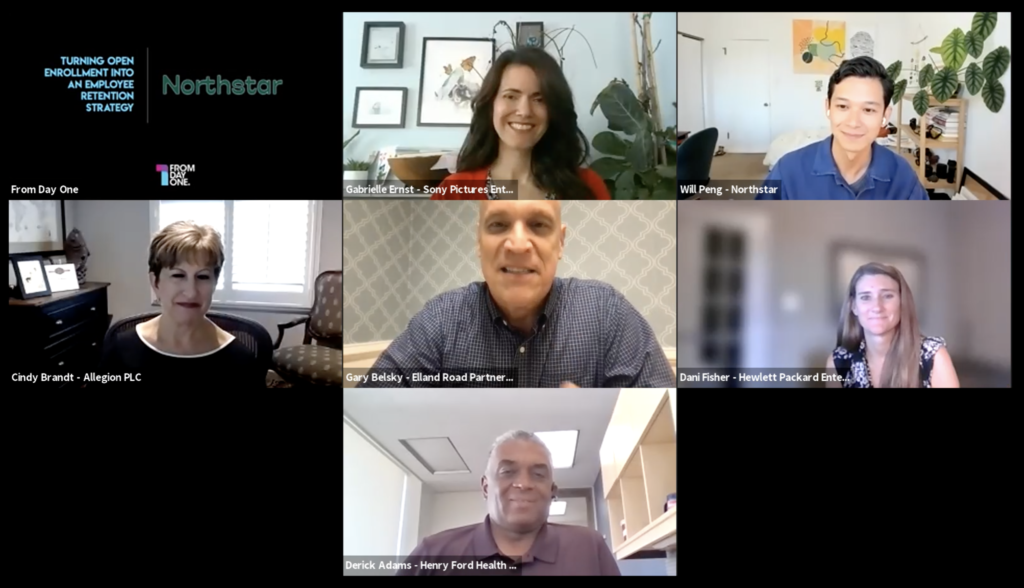Turning Open Enrollment Into an Employee Retention Strategy


Amid today’s tough competition for workers, attracting and retaining valued employees doesn’t just hinge on paying competitive salaries, offering a flexible schedule, and creating a welcoming corporate culture. A generous slate of benefits can play a crucial role as well, making the fall annual open enrollment period–when employees must chose health insurance plans and other benefits for the coming year–all the more important. “It’s an opportunity to showcase all the great compensation and benefits changes that you're making,” said Will Peng, CEO and co-founder of Northstar, a financial-wellness platform for employers.
Yet this process can be overwhelming for some workers, who may see this short window as more of a hassle than an opportunity to make the most of their benefits. Dani Fischer, a senior director of global benefits at Hewlett Packard Enterprise, said that employee feedback about open enrollment has a consistent theme: “Benefits are hard, benefits are expensive, I need support, and I need somebody to just help me do this.” The fact that these decisions can be high-stakes adds to the pressure. “If you talk to the employees, they’re going to tell you that they’re anxious about it, because this is kind of make-or-break for the next 12 months,” said Derick Adams, VP of total rewards at the Henry Ford Health System in Detroit.
What companies can do to help employees understand, value, and take advantage of their benefits was the theme of a From Day One webinar last week, “Turning Open Enrollment Into an Employee Retention Strategy,” which brought together five employee-benefits experts to talk about best practices and share ideas, moderated by Gary Belsky, president of the media consulting firm Elland Road Partners.
Presenting a menu of benefits during open enrollment can reinforce that your company is a great place to work, but employees need to understand what they’re being offered. Peng noted that employees crave information: MetLife’s annual benefits survey found that 55% of employees wished they were more informed about their benefits so they could get more value out of them. Yet as the HR leaders on the panel explained, companies must balance ample and clear communications with not inundating workers with so much material that they block it out. “We try to bundle communication so that we're not hitting them all the time,” said Fischer. “But especially with the pandemic, it feels like so many more emails have come out that I think we've gotten lost a little bit in the noise.”
To make open enrollment less overwhelming, Adams noted that his organization played down voluntary benefits that employees can sign up for at any time during the year. “That's our attempt to make it so that there's not as much anxiety around it,” he said. Sony Pictures Entertainment tries to make open enrollment materials more engaging by drawing on the company’s products, said Gabrielle Ernst, the company’s VP for compensation and benefits. “When we first rebranded everything, we called it a benefits voyage and the imagery that we used was from Hotel Transylvania,” she said.

Educating employees about their benefits options during open enrollment is typically a multi-pronged operation, combining paper mailings with online tools, virtual assistants, call centers, employee education sessions, and even advisors to help. “Some may want to come to a meeting, some prefer self-service and going to a website, some may want to have a one-on-one session,” said Cindy Brandt, director of global payroll and benefits for Allegion, the security-systems company. “We try to provide all of these different options because everybody is at a different place.” Her company also educates managers about benefits options, because employees with questions often reach out to their supervisors first.
Offering employees access to outside financial coaches can help them analyze benefits choices in the context of their finances and future plans. Deciding what health insurance plan to sign up for, for example, may depend on a family's ability to handle out-of-pocket costs and comfort with taking that risk. “These are not only benefits decisions, but also financial decisions,” said Northstar's Peng. “It’s really difficult to get perfect information, and that's why being able to talk to a trusted third party is so important.”
Providing information about open enrollment can also involve communicating with non-employees, such as spouses and partners. “We know 50% of the people making choices aren't the ones that are the employees, they’re the people at home that are making those decisions as well,” said Ernst. “So we’ve made it easier to access information.”
Of course, for all the pressure put on open enrollment, this annual fall window isn’t necessarily the only time workers will be thinking about benefits. Life changes, like a marriage or the arrival of a child, can also spark interest in what an employer has to offer, and highlighting those benefits throughout the year has value. “People don't make life decisions only around open enrollment,” Peng noted, “and being able to proactively say, ‘Hey, we have this great set of benefits, and we want to show you how to use them’ can happen year-round.”

At Hewlett Packard Enterprises, Fischer said, the company is starting to become more proactive about alerting employees about benefits they may qualify for via a third-party personal care team. “Our employees are probably gonna be a bit skeptical at first,” said Fischer. “But the care team is built to really get them where they need to go based on what they're dealing with.”
In the end, do top-tier benefits keep employees from jumping ship? According to the Society of Human Resource Management (SHRM), employee benefits “play a role in retention. Offering a competitive benefits package, in addition to competitive pay, reduces the likelihood an employee will find the grass greener elsewhere.” Allegion’s Brandt thinks a generous benefits package has even more leverage at the front end of an employee's experience with a company. “It absolutely goes into their decision on whether they want to join a company,” she said. Added Sony’s Ernst: “I see more and more applicants asking questions related to benefits and what type of services we offer.” For new college graduates, that might be whether a company offers repayment programs for student loans. Others might ask about family-planning services, such as coverage for fertility treatments or adoptions.
The elevation of benefits as a factor in job searches means employers may want to be more public about their offerings. There's an opportunity in making benefits more outward facing, said Peng. “We think that the employee experience extends to the candidate experience, as well.”
Ellen Stark writes about personal finance, business, entrepreneurship, and philanthropy. She is the former deputy editor at Money magazine, where she worked as a writer and editor for more than 20 years.
The From Day One Newsletter is a monthly roundup of articles, features, and editorials on innovative ways for companies to forge stronger relationships with their employees, customers, and communities.